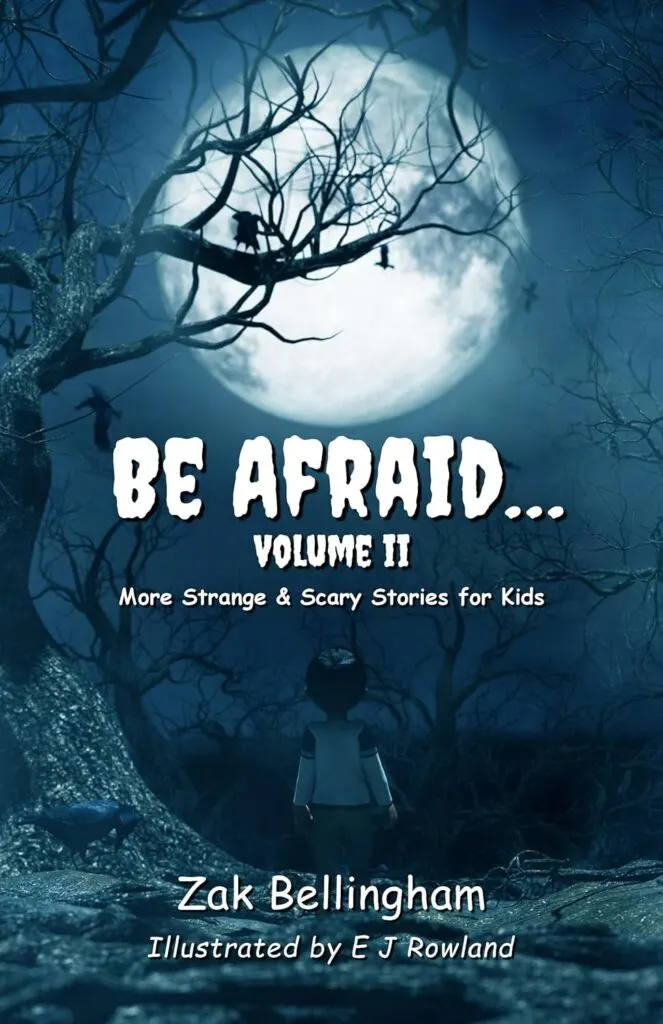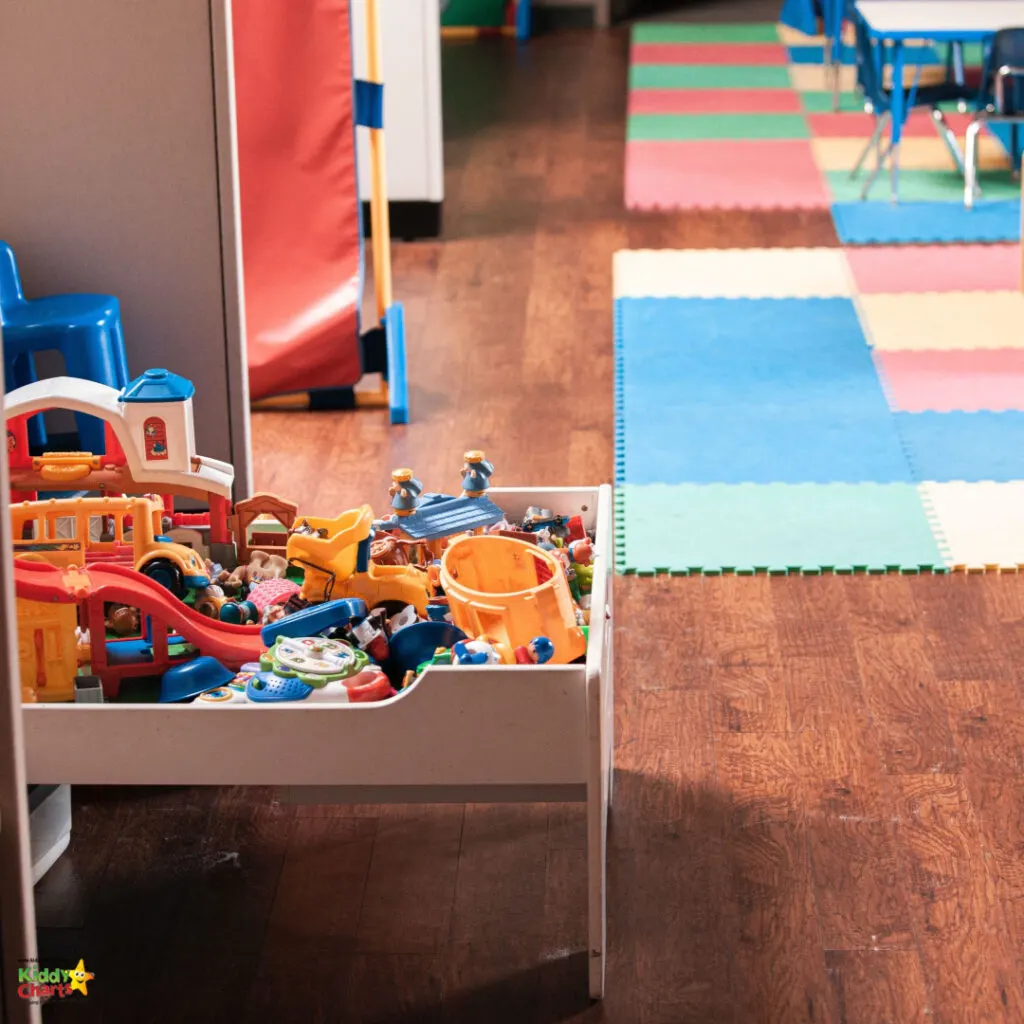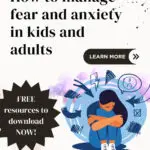For adults and children, learning how to manage fear and anxiety is an important part of regulating emotions, and worry. Worry is a completely natural emotion, and a little bit of it is important to help us prepare, develop resilience and build strength.
When our worries become overwhelming, and seem to kick in when the situation doesn’t really warrant it, we are straying into anxious territory. If we have had a particularly traumatic experience, or we have a brain that is wired differently, anxiety can become a part of our everyday life. It is harder to regulate our emotions, and we might find it more difficult to stave off our anxieties and fears.

Today, we are going to give some basic strategies for managing anxiety and fear. These really are only the tip of the iceberg. There are loads of ideas and thoughts for us all out there; it is important to find the strategies that work for YOU. We are all different. Before checking these out, don’t forget to download our coping with anxiety flashcards for kids and adults. These have some great mantras on to help keep anxiety at bay.
5 techniques to help children manage anxiety
Let’s start with kids first!
1. Provide them with ways to process their feelings
The first step in assisting children is understanding and validating their feelings. Recognise their fear and reassure them that it’s normal to feel scared occasionally. We have a few ideas for looking at this, and giving context to those fears on site, and there are also some excellent books that help children to understand worry, fear, and develop positive wellbeing. Zak Bellingham has a series of three books all about being afraid that introduce fears to kids, and helps them see how they can be overcome.



Zak Bellingham’s “Be Afraid” series, includes:
- Be Afraid… A Little Book of Strange & Scary Stories for Kids,
- Be Afraid… Volume II: More Strange & Scary Stories for Kids, and
- Be Afraid… Volume III: Strange Stories for Kids and Grown-Ups.
The series offers an interesting approach to teaching children about fear and anxiety. Zak shares a collection of strange and scary stories that capture the imagination and engage readers. Bellingham carefully crafts each story to provoke feelings of fear and anxiety. This offers young readers an opportunity to experience these emotions in a safe and controlled setting.
As the series progresses, the stories evolve to cater to both children and adults, broadening the scope of its audience. Through these stories, children can learn to understand their fears and anxieties better, equipping them with the knowledge and tools to manage such emotions effectively. The series has received positive reviews for its engaging content and pedagogical approach to addressing fear and anxiety.
Alongside these books, we also have a collection of amazing booklists for wellbeing too for all kids ages, that are well worth exploring for ideas.
In addition to these resources, it sometimes helps children, and even adults, to understand that there are different levels of worry and anxiety. We have a mood rating tool that can support this concept in understanding anxiety in kids. Our worry tree is also popular. Sometimes talking about our worries and getting them out of our heads gives children more power over them. We also have a worry jar, as well as worry worksheets too.
2. Listen empathetically to them
We have given you a few pointers previously on listening with empathy to our kids, and part of helping them to manage their anxiety and fear, is giving them a safe space where they can talk and express themselves, and be acknowledged and understand. We need to really listen to our kids, so that they can express themselves. And don’t just do this for the short term, acknowledging and emphasing with smaller-common fears, can help kids to understand that we will accept their feelings, making it easier in the long term for them to manage those feelings of fear when they get that little bit bigger!

Life does hit us with negative emotions, and helping our kids to recognise the physical symptoms of those emotions and to name them gives our kids power over them too. We cannot protect. We need to enable our children to embrace life’s ups and downs safely.
3. Teach beep breathing techniques
Deep breathing can be an effective tool for children. Teach them to take slow, deep breaths when they feel anxious or scared. This technique will help slow their heart rate and calm their mind. Sometimes it helps children to use their hands while they breathe, or trace a shape. We have a couple of breathing exercises on the site which are worth taking a look at. Breathing can help kids to calm anxious thoughts, reducing worry and anxiety levels by changing a child’s focus from the anxiety symptoms to something completely different.
3. Use imaginative play
Children possess a vibrant imagination. Utilise this to help them cope with their fears. Create stories where they conquer their fears, transforming scary situations into adventures. Zak’s books are a great starting point for this. You could even use our finger puppets perhaps? Why not get kids to make up their own stories after reading them together, helping them to discuss their fears? You might ask things like:
- What are they afraid of?
- What makes this scary?
- Can you write a story about something frightening that happened?
- What would you change about how you actually reacted in your story?
- What would you do next time?
All of these questions help children to think about how they might do things differently, and can build problem solving, which in turn, builds resilience.

4. Gently encourage gradual exposure
If your child has a specific fear, gradual exposure can help, though as with adults, it is important to be careful about this, and not push at all if your child doesn’t want to do something. This MUST be child-led, and not adult pushed. We do have an activity on the site helping kids to face their fears through the use of a set of steps, so they are able to “work up to” their anxieties. Start by showing pictures, then gradually increase the exposure until they’re ready to face the fear directly.
It is important to understand the differences between our children though. “Telling” some children what to do and when can be damaging, particularly with school fears, and neurodivergent children. Neurodivergent kids very often do not like being “told” what to do. Demands can be anxiety inducing in themselves to ADHD or Autistic children.
5. Employ grounding techniques
Anxiety is caused by our body believing we are in danger when we are not – it results in our bodies employing the primitive fight-flight-freeze-friend-faun response when it isn’t needed. It kicks in when our primitive brain takes over from our logical one.
Grounding techniques are designed to help us employ our conscious brain to try to over-ride that responses, calming us down, and potentially staving off panic attacks.
A classic technique is the 5-4-3-2-1 senses technique where we notice around us the following, helping us to come back into the present moment, and not be drawn into the usual patterns of our anxiety:
- 5 things you can see,
- 4 things you can feel,
- 3 things you can hear,
- 2 things you can smell, and
- 1 thing you can taste.
It is a technique that is easy to teach to kids, so why not give it a go?
6. Seek Professional Help
Finally, as always, we would advise you to seek professional help if the child’s anxiety is severe or leads to panic attacks regularly that are distressing for them. Professional help may be necessary. Therapies such as CBT, and person-centred counselling (particular for those children that are neurodivergent), can be adapted for children and can teach them strategies to manage their anxiety effectively. Play therapy is extremely powerful for younger children too.
If you are looking to manage anxiety as an adult, some of the strategies are similar, but, of course, adults can have a little more autonomy to change their environments. Sadly, for children, it is sometimes not as easy for them to take control simple because of their environment or the situations that they are in which they are unable to control.

2: Strategies for Adults to Manage Anxiety & Fear
In today’s fast-paced society, adults often find themselves grappling with the complexities of stress and worry. Anxiety disorders are increasingly diagnosed within adults, and it is vital to aknowledge that more of us need support managing anxiety and stress.
Here are five strategies to help adults manage anxiety:
1. Identify and manage triggers:
The first step towards managing anxiety is recognising the triggers for our anxiety. Trigger might be a particular situation, or even a person. Spotting when your anxiety is rising, and being more conscious about it can in of itself, help to ease our stress.
For example, if you know phone calls in your daily life from a certain individual can trigger worry, and sometimes in extreme circumstances a panic attack, consider what it is about that person that develops those feelings within yourself.
Things that you might want to think about might include:
- Where in your body do you feel it?
- What have you done in the past to help those feelings?
- Is the person talking anxious themselves, and you are “letting in” their anxiety and taking it on?
- How have you managed to stay calm before?

Anxiety-inducing moments could range from stressful situations at work to any social interactions that cause discomfort. Identifying these triggers is analogous to mapping out a route before embarking on a journey. Once these triggers are identified, you can strategise ways to manage them, by being prepared, or doing them when youy are feeling calm, or safe.
For example, personally, to make a difficult phone call, being outside to do it reduces the stress that phone call causes, so walking and talking can work for some to keep yourself grounded.
2. Practice mindfulness meditation:
Mindfulness meditation is a potent tool to combat anxiety. It cultivates an awareness of the present moment, keeping you in the moment, and helping to dispel some of those negative thoughts and reducing the feelings of anxiety and so the stress response associated with what our body perceives as potential threats. While mindfulness can offer short-term relief from anxious feelings, the benefits extend into long-term emotional health by fostering a healthier response to irrational fears and lowering heart rate during episodes of intense fear.
In PTSD, for example, our bodies can get “trapped” in the traumatic experience, and react as if we were back there again, creating a physical reaction to a threat that is no-longer there – even kicking in the fight or flight response. Mindfulness can be a helpful way to bring us back to the present time, and start to begin to teach us that the anxiety and stress response is from the past and NOT the present.

You might want to consider our mindfulness 30-day challenge to help you get kick-started.
3. Seeking professional help
Cognitive Behavioral Therapy (CBT) and Exposure Therapy are two treatments that have been proven to be effective for anxiety disorders, alongside talking therapies such as counselling. CBT aids in understanding and modifying thought patterns leading to anxiety, while exposure therapy incrementally introduces you to the situations you fear in a controlled, safe environment, enhancing your coping mechanisms.
It is absolutely vital to work with professionals on both these types of therapies, so that individuals can be introduced gently to situations that generate a fear response safely. It is critical that adults are not exposed to a stressful situation without professional support. For a traumatic event, is it not appropriate to take adults back to their traumas, so adults should not be put into such dangerous situations without support.
4. Deep breathing exercises
Deep breathing exercises function as a natural soother for our parasympathetic nervous system, the part of us that is automatic, and can result in our body reacting as though we are under threat, when we are not. Employing breathing techniques helps both distract us bring our logical brain back into the room, It also helps to slow our heart rate and control the physical sensations associated with anxiety.

5. Reach out to a support network
Having a confidant to share your feelings with can provide immense relief. A trusted family member or friend can offer emotional support and reassurance, a safe harbor in the tumultuous sea of stress. it doesn’t have to be a professional ear, sometimes any ear will do! Don’t be afraid to reach out and lean on those closest to you during times of stress.
6. Practice self-care
Self-care is not a luxury, but a necessity for maintaining our mental health. Taking care of ourselves physically, emotionally, and mentally can help reduce the impact of stress on our lives. This includes getting enough sleep, eating well-balanced meals, exercising regularly, and setting aside time for activities that bring us joy and relaxation. Remember to prioritise your own well-being and make time for self-care every day. We do have a self-care planner for you that might be helpful. Why not pop over to the shop and take a look?

Patience is important in tackling fear and anxiety
Remember, managing anxiety and fear is a journey, not a destination. It requires time, patience, and potentially professional help. Whether you’re an adult or a child, the crucial first step is understanding and managing your anxiety. No one should have to live in constant fear or worry. With the right tools and support, we can all lead happier, healthier lives.
The road to managing anxiety and fear might be challenging, but it’s not insurmountable. In the words of Ralph Waldo Emerson, “Do not go where the path may lead, go instead where there is no path and leave a trail.” You are not alone in this journey, and with resilience and perseverance, you can navigate your way towards a more peaceful life.
It’s important to recognise that anxiety and fear are natural emotions that we all experience. They serve as a warning system to keep us safe and alert in potentially dangerous situations. However, when these feelings become overwhelming and interfere with our daily lives, it may be a sign of something more.

Other resources to help
If you suspect you may have an anxiety disorder, or that your child does, seeking help is the first step towards managing it effectively. There are many treatment options available, including therapy, medication, and lifestyle changes. It’s essential to find a treatment plan that works best for you, your children, and your specific needs.
We really hope that you have find this introduction useful. We do have a number of resources on the site that are focused on stress, anxiety, and mindfulness both in adults and children. Do take the time to explore what we have so that you can find the ideas that are right for you, or your child.
Anxiety in kids
Ideas from KiddyCharts to help with kids expressing themselves, and focusing on improving mental health.
Anxiety in kids: Download these tools today to help your kids to talk
Some tools for you to help alongside these ones we have already provided.
Care 4 Me Reward Charts – Reduce separation anxiety today!
If your child suffers from separation anxiety - why not try our free care charts too?
Free worry tree to help ease your kids fears
A worry tree to help younger children voice, and externalise their anxieties.
5 ways to use reading to help anxiety in kids: Includes FREE friendship bookmarks and book bundle giveaway #TimeToRead
Using reading to help reduce anxiety too.
There are other articles off site that you might want to check out too – so do take a look here as well at other relevant resources for anxiety and stress.
Anxiety and fear resources off site
Here are some other resources off site that you might want to check out around anxiety.
Parenting 101: Top Tips To Prevent Anxiety In Kids
Some tips to help prevent anxiety - though of course, we are talking overwhelming anxiety. A little worry in our children is 100% natural and it is important for children to understand this too.
Parental Anxiety: How to NOT Pass on Your Anxieties to Your Kids
This is important. We should not be blamed for anxiety in children as parents. We would do wise to acknowledge that our own emotional regulation is important in helping our children to learn to regulate their emotions. Anxiety is no different. We set examples in other ways, and it is important to do the same with our emotional intelligence.
Recognizing the Signs of Anxiety in Kids and Teens
Some support and help for recognising anxiety in our children. It is, of course, important not to self-diagnose social anxiety, or general anxiety disorder, so it is always important to get a professional, medical view.
Managing anxiety, and stress seems to be a part of modern life, but it doesn’t have to be something that you do alone.
We understand that seeking help for mental health issues can be daunting, especially for parents trying to navigate their child’s well-being. That’s why we have developed our site, and the resources that we have, largely for free, to help and support you when, and wherever you need it. If there are other resources that you would like us to create, just contact us, and we can see what we can do for you.
If you like what you see here, why not sign up to our weekly newsletter for more articles and ideas from the site – we try and produce a printable at least every other week, and we sometimes manage to weekly, depending on how busy we get.
Thanks for coming to see us all, and we really hope that we can catch up with you again soon on here.
Take care,
Helen









